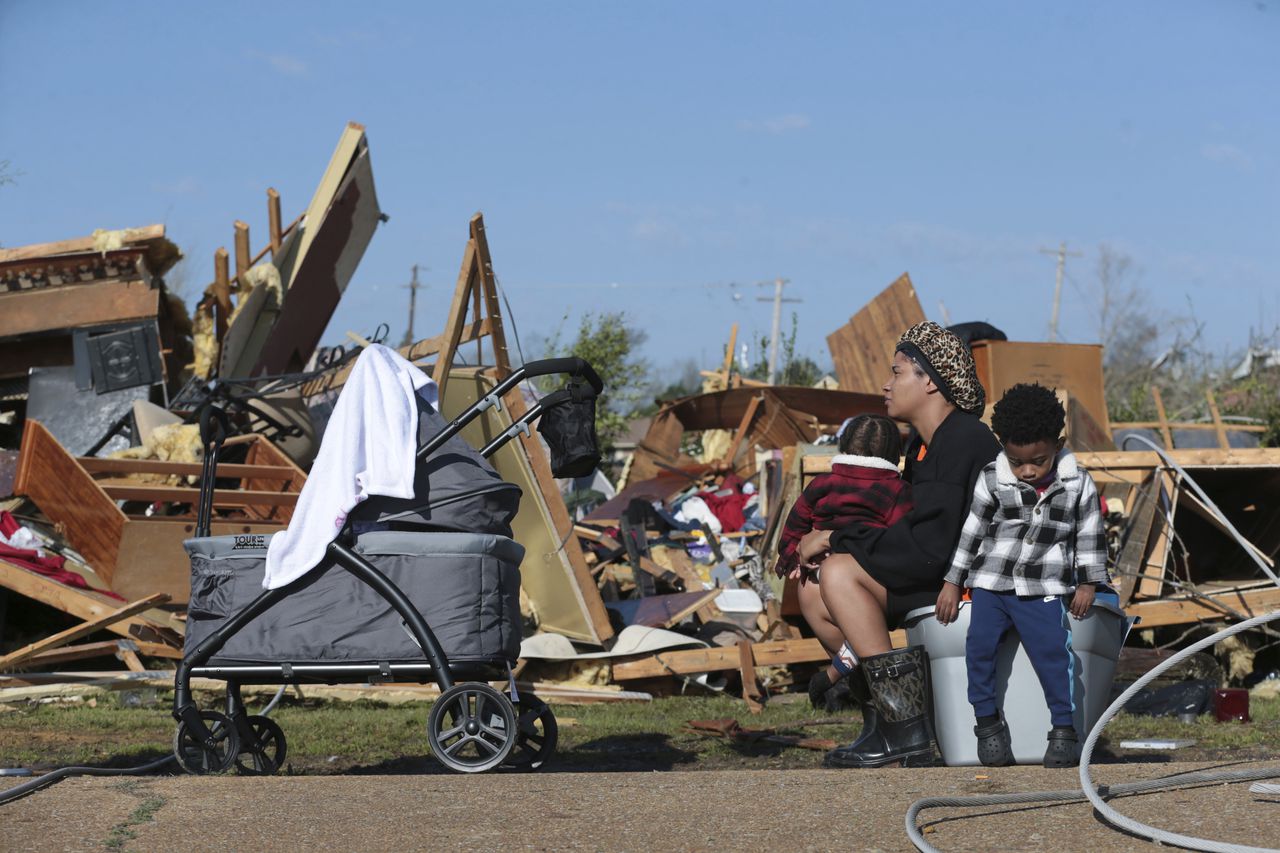Federal aid coming to Mississippi, where storms killed 25
By LEAH WILLINGHAM Associated Press
President Joe Biden issued an emergency declaration for Mississippi early Sunday, making federal funding available to the areas hardest hit Friday night by a deadly tornado that ripped through the Mississippi Delta, one of the poorest regions of the U.S.
At least 25 people were killed and dozens of others were injured in Mississippi as the massive storm ripped through several towns on its hour-long path. One man was killed after his trailer home flipped several times in Alabama.
Search and recovery crews on Sunday resumed the daunting task of digging through the debris of flattened and battered homes, commercial buildings and municipal offices after hundreds of people were displaced, even as the National Weather Service warned of a risk of more severe weather Sunday — including high winds, large hail and possible tornadoes in Louisiana, Mississippi, Alabama and Georgia.
A tornado reportedly touched down early Sunday in Troup County, Georgia, near the Alabama border, according to the Georgia Mutual Aid Group. Affected areas included the county seat of LaGrange, about 67 miles (about 108 kilometers) southwest of Atlanta.
“Many buildings damaged, people trapped,” GMAG said on Facebook. In nearby West Point, roads, including Interstate Highway 85, were blocked by debris.
The Troup County Sheriff’s Office said it was responding to reports of downed trees and power lines and damaged homes. A tiger was reported missing at the Wild Animal Safari in Pine Mountain. Calls there were not answered early Sunday.
“If you do not have to get on the roads this morning please do not travel,” the agency said on Facebook.
Some outages in cell service were reported after a suspected tornado struck the area around dawn Sunday, the Troup County Sheriff’s Office said.
Following Biden’s declaration, federal funding can be used for recovery efforts in Mississippi’s Carroll, Humphreys, Monroe and Sharkey counties, including temporary housing, home repairs, loans covering uninsured property losses and other individual and business programs, the White House said in a statement.
The twister flattened entire blocks, obliterated houses, ripped a steeple off a church and toppled a municipal water tower.
Based on early data, the tornado received a preliminary EF-4 rating, the National Weather Service office in Jackson said late Saturday in a tweet. An EF-4 tornado has top wind gusts between 166 mph and 200 mph (265 kph and 320 kph), according to the service. The Jackson office cautioned it was still gathering information on the tornado.
The tornado devastated a swath of the 2,000-person town of Rolling Fork, reducing homes to piles of rubble and flipping cars on their sides. Other parts of the Deep South were digging out from damage caused by other suspected twisters. One man died in Morgan County, Alabama, the sheriff’s department there said in a tweet.
The Federal Emergency Management Agency said in a briefing that 25 people were confirmed killed, 55 people were injured and 2,000 homes were damaged or destroyed. High winds, hail and strong storms were expected for parts of Alabama and Georgia on Sunday, the National Weather Service said.
“How anybody survived is unknown by me,” said Rodney Porter, who lives 20 miles (32 kilometers) south of Rolling Fork. When the storm hit Friday night, he immediately drove there to assist in any way he could. Porter arrived to find “total devastation” and said he smelled natural gas and heard people screaming for help in the dark.
“Houses are gone, houses stacked on top of houses with vehicles on top of that,” he said.
Annette Body drove to the hard-hit town of Silver City from nearby Belozi to survey the damage. She said she was feeling “blessed” because her own home was not destroyed, but other people she knows lost everything.
“Cried last night, cried this morning,” she said, looking around at flattened homes. “They said you need to take cover, but it happened so fast a lot of people didn’t even get a chance to take cover.”
Storm survivors walked around Saturday, many dazed and in shock, as they broke through thickly clustered debris and fallen trees with chain saws, searching for survivors. Power lines were pinned under decades-old oaks, their roots torn from the ground.
Mississippi Gov. Tate Reeves issued a state of emergency and vowed to help rebuild as he viewed the damage in a region speckled with wide expanses of cotton, corn and soybean fields and catfish farming ponds. He spoke with Biden, who also held a call with the state’s congressional delegation.
More than a half-dozen shelters were opened in Mississippi to house those who have been displaced.
Preliminary information based on estimates from storm reports and radar data indicate the tornado was on the ground for more than an hour and traversed at least 170 miles (274 kilometers), said Lance Perrilloux, a meteorologist with the National Weather Service’s Jackson, Mississippi, office.
“That’s rare — very, very rare,” he said, attributing the long path to widespread atmospheric instability.
Perrilloux said preliminary findings showed the tornado began its path of destruction just southwest of Rolling Fork before continuing northeast toward the rural communities of Midnight and Silver City and onward toward Tchula, Black Hawk and Winona.
The supercell that produced the deadly twister also appeared to produce tornadoes causing damage in northwest and north-central Alabama, said Brian Squitieri, a severe storms forecaster with the weather service’s Storm Prediction Center in Norman, Oklahoma.
___
Associated Press writers Emily Wagster Pettus in Rolling Fork, Mississippi; Michael Goldberg in Silver City, Mississippi; Jim Salter in O’Fallon, Missouri; and Nicole Winfield in Rome contributed to this report.
